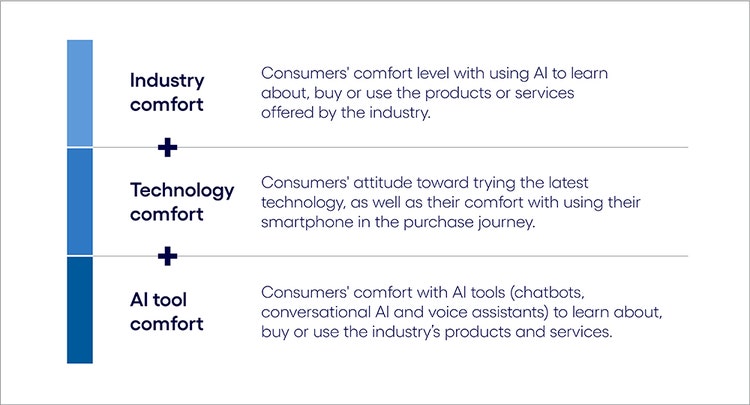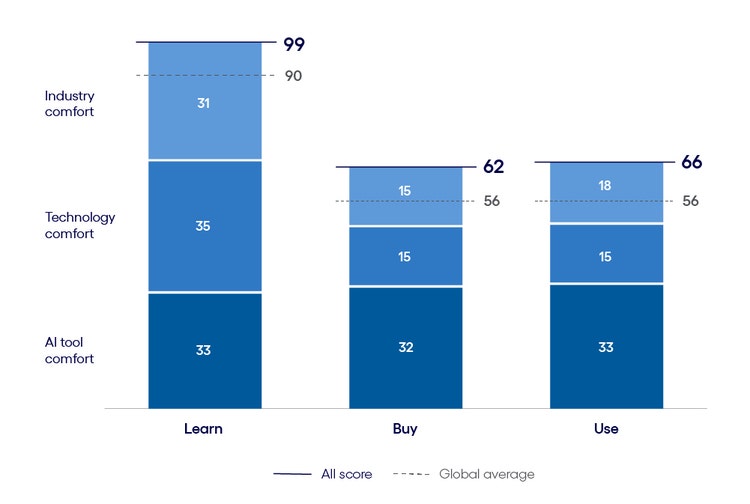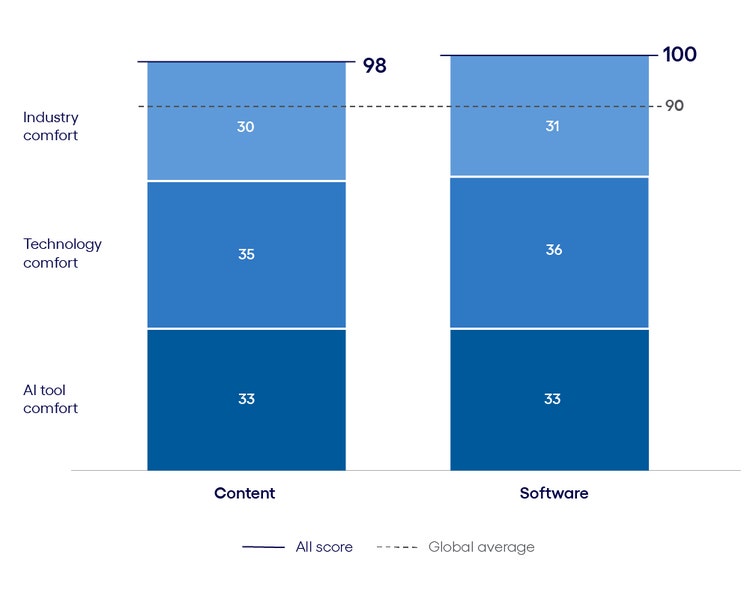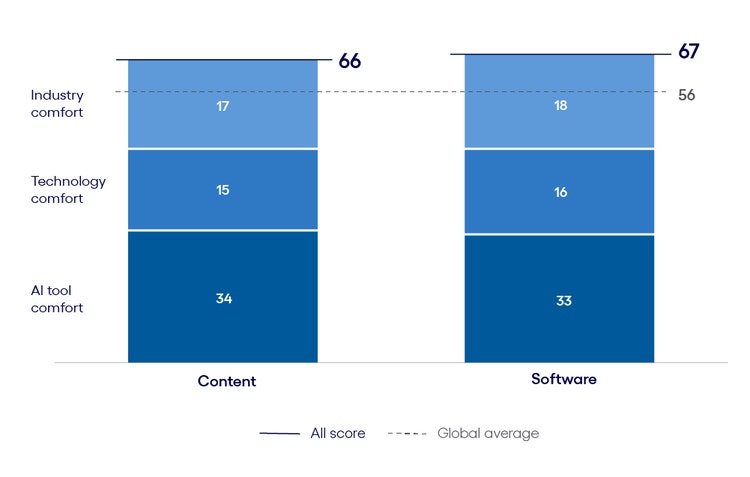<p><br> <span class="small">August 11, 2025</span></p>
Consumer AI adoption will shake up the media and tech customer experience
<p><b>Our AI Inclination Index reveals which consumers are most open to using AI when engaging with media and technology businesses—as well as where and how they’ll use it. Knowing this, media and tech organizations can develop a highly nuanced and effective consumer-facing AI strategy.</b></p>
<p>While media and technology businesses have long pioneered the use of AI for personalized recommendations, consumers still deal with overwhelming choice and complexity—not to mention “subscription fatigue”—when seeking new content and software across a fragmented ecosystem of platforms.</p> <p>Now, a new generation of AI-driven tools is emerging, most recently in the form of consumer AI agents. These agents promise to create a more unified customer experience, operating across different media and technology services on a consumer's behalf. For example, such an agent could curate a playlist from multiple music services or find the optimal software solution from any vendor.</p> <p>According to our recent research, consumers of media and technology products are ready and waiting to use AI tools. But this transition to a more powerful, cross-platform AI customer experience signifies a major change for media and tech companies, and a potential transfer of control. The very platforms that built their success on proprietary recommendation engines now face the possibility of being disintermediated. This will have major ramifications for companies accustomed to retaining users within their own walled-garden ecosystems.</p> <p>As glimmers of this future appear, media and tech companies need to better understand how AI will change consumer behavior. Which consumers are most (and least) inclined to use AI? Which tool would they prefer to use? And where in the process would they be most comfortable using it?</p> <p>Our recent research uncovered some surprising answers to those questions. Using data from our recent consumer AI study, we developed the AI Inclination Index, which quantifies consumers’ propensity to use AI. While consumer interest in using AI for media and technology purchases exceeds the cross-industry average, there are important variations in AI attitudes across the three key phases of the consumer journey (Learn, Buy and Use) and the two media and technology segments defined in our study: </p> <ul> <li><b>Content </b>(music, books, television, movies, news, video games)</li> <li><b>Software</b> (productivity and office software, specialized AI-driven tools and applications)</li> </ul> <p><b>Here are three key findings on AI adoption across the media and technology consumer experience:</b></p> <ul> <li><b>AI inclination is exceptionally high in the Learn phase</b>. AI inclination surpasses the global average in all three phases of the customer experience journey, but it peaks in the Learn phase with a score of 99. While interest dips in the Buy phase, it then rebounds in the Use phase. This post-purchase uptick is a key differentiator for the sector and suggests a strong appetite for ongoing AI engagement with content and software.<br> <br> </li> <li><b>Younger consumers are the definitive AI enthusiasts</b>. AI inclination is highest among the 18–24 and 25–34 age groups and declines steadily as age increases. This indicates that younger, digitally native cohorts, who are often the biggest consumers of digital media and new software, are the primary drivers of AI adoption, leveraging these tools for discovery and engagement more readily than older groups.<br> <br> </li> <li><b>Conversational AI is the tool of choice</b>. In both the content and software product categories, conversational AI is the preferred tool by a significant margin. Its ability to handle complex discovery queries makes it invaluable in the Learn phase, and it remains the top choice in the post-purchase Use phase, particularly for software. This suggests a strong consumer desire for conversational support, troubleshooting and ongoing interaction with technology products after the initial transaction.</li> </ul> <p><b>The AI Inclination Index</b></p> <p><i>To quantify consumers' propensity to adopt AI-driven technology features throughout the consumer journey, we developed the AI Inclination Index. The index was calculated using three measures from our New minds, new markets survey data.</i></p>

#
<p><b><br> AI inclination in media and tech vs. the global average</b></p> <p><i>Consumers are consistently more inclined to use AI when learning about, purchasing and using media and technology products and services compared with the cross-industry average.</i></p>

#
<p><span class="small">Figure 1 <br> Base: 8,451 respondents in the US, UK, Germany and Australia<br> Source: Cognizant Research </span></p> <p>With these variances across consumer groups and journey stages, it’s clear media and tech companies will need to craft a precise and nuanced AI strategy that captures the greatest areas of opportunity while avoiding low-value pursuits. </p> <p>Understanding consumer use of AI, as well as the accompanying pockets of spending power, is essential for leaders in all industries. In our global study “<a href="https://www.cognizant.com/us/en/aem-i/new-minds-new-markets-ai-customer-experience" target="_blank">New minds, new markets</a>,” we found that consumers who are enthusiastic about AI will account for up to 55% of all purchases made across industries. This amounts to $4.4 trillion in spending in the US, $690 billion in the UK, $690 billion in Australia and $540 billion in Germany. </p> <p>In this report, media and technology leaders will learn where in the purchase journey consumers are most and least inclined to use AI, the AI tools they would be most apt to use and how this differs across age groups. With this information, businesses can reshape their approach to using AI in the customer experience—where and how it matters most.</p>
<h4>AI across the media and tech customer experience: A uniquely mature ecosystem</h4> <p>As our data indicates, consumer inclination to use AI in the media and tech sector is exceptionally high, consistently surpassing the global cross-industry average in every phase of the journey. The AI Inclination Index score peaks at a near-perfect 99 in the Learn phase (vs. 90 globally) and remains strong through the Buy and Use phases, with scores of 62 and 66, respectively, vs. 56 for the global average.</p> <p>This advanced starting point for AI adoption can be attributed to several factors inherent to the sector. For years, media and tech consumers have been conditioned by AI-powered recommendation engines that are central to the user experience on major content platforms like Netflix, YouTube and Spotify. Unlike many other industries, consumers in this space have long trusted AI to help them discover content and navigate vast libraries, creating a baseline of familiarity and acceptance.</p> <p>Furthermore, the products themselves, including digital music, movies, games and software applications, are natively digital, allowing AI to analyze, manage and deliver them without the physical-world friction present in other sectors. The low-risk, often instantaneous nature of these digital transactions and their post-purchase use further lowers the barrier for consumers to embrace AI across their entire journey.</p>
About our analysis
To understand consumer AI behaviors and attitudes at a granular level, we structured our analysis around four key pillars:
- The consumer journey. We studied the specifics of AI use at each phase of the customer journey. This journey—how consumers discover, purchase and engage with products and services before and after a sale—is at the heart of the business-customer relationship.
- Consumer demographics. To gain a better understanding of how consumer attitudes and behaviors differ by age group, we divided consumers into five categories: 18-24, 25-34, 35-44, 45-54, and 55+.
- Consumer AI tools. We defined consumer AI use by asking about their intended use of three key tools that are prevalent in the consumer world: voice assistants, chatbots and conversational AI.
- Industry-specific products. We included two media and tech product categories in our analysis: content and software.
<h5>The Learn phase: AI is the default for discovery</h5> <ul> <li><span class="eds-label">High technology comfort levels create a springboard for AI adoption</span></li> </ul> <ul> <li><span class="eds-label">Software products see peak levels of AI inclination for consumers</span></li> </ul> <ul> <li><span class="eds-label">AI excels at taming media choice overload</span></li> </ul> <p>The Learn phase is where media and technology consumers are fully comfortable with using AI-enabled tools. This reflects a consumer base long accustomed to AI discovery on major content and software platforms.</p> <p>This dynamic is already visible in sophisticated AI agents that can field complex discovery queries across multiple platforms. For example, a consumer can now ask an AI, "Find a new sci-fi series with a richly detailed universe that's included in my current streaming subscriptions," and receive a single, curated list of options from services like Netflix, Disney+ and Prime Video, complete with reviews and trailers.</p> <p>With AI now central to discovery, the Learn phase represents a critical opportunity for media and tech companies to ensure their offerings are visible and compelling to these new AI gatekeepers.</p> <p><b>Media and tech AI Inclination Index: The Learn phase</b></p>

#
<p><span class="small">Figure 2 <br> Base: 8,451 respondents in the US, UK, Germany and Australia<br> Source: Cognizant Research</span></p> <p><b>High technology comfort levels create a springboard for AI adoption</b></p> <p>A key driver of the high inclination scores for media and tech is consumers’ exceptional comfort with the underlying digital platforms. This is reflected in the very high score in the technology comfort component of the index, at 35.</p> <p>This is a crucial differentiator for the industry. While consumers in other sectors might have reservations about using a digital interface, the smartphone or personal computer is the native, primary environment for media and tech consumption.</p> <p>This foundational digital fluency removes a major layer of friction. Because consumers are already experts at navigating their devices, they are more willing and able to embrace the advanced AI capabilities built on top of them. This creates a powerful springboard for the adoption of even the most sophisticated AI agents and tools—a readiness reflected in the high AI tool comfort score of 33.</p> <p><b>Software products see peak levels of AI inclination for consumers</b></p> <p>Of all product categories in the 14 sectors covered in our cross-industry study, software registers the highest possible inclination index score of 100. This suggests that when consumers are looking for a way to streamline their research of new technology, AI is seen as an essential partner.</p> <p>This perfect score is likely because consumers searching for software are typically trying to solve a specific problem or accomplish a distinct task. They appreciate AI's ability to cut through technical jargon and compare a multitude of options based on their unique requirements.</p> <p>For example, a user could ask an AI agent, "What is the best video editing software for a beginner on a Mac that can handle 4K footage and includes a good stock music library?" Instead of spending hours reading reviews and technical specification sheets, the AI tool could produce a concise comparison of the top contenders, breaking down their respective learning curves, pricing models (one-time vs. subscription) and feature quality.</p> <p>By efficiently parsing these complex feature sets, checking compatibility requirements and comparing intricate pricing models, AI performs a task that is time-consuming and difficult to do manually.</p> <p>For software vendors, this means having an AI-discoverable and AI-friendly product information strategy is essential for capturing consumers’ attention at this phase.</p> <p><b>AI excels at taming media choice overload</b></p> <p>In addition to technical complexity, the exceptionally high AI inclination scores in the Learn phase are driven by another key customer frustration: choice overload. This is seen in the inclination score of 98 for media products.</p> <p>Consumers embrace AI as an essential filter to combat the decision fatigue that comes from navigating millions of options across countless streaming services. An AI agent can parse a user's subscriptions and taste profile to recommend a specific film or series, saving both time and the potential cost of adding another service.</p> <p>As consumers grow more ambitious, they see even greater potential for AI-driven curation, as expressed by a 51-year-old respondent from Australia: “It would be interesting to use AI to compose programs, for example, curating a news show with only particular types of stories or a summary of a sports contest showing only key events or scoring events.”</p> <p>Interestingly, AI-based discovery of media has strong appeal among lower- and middle-income consumers, who exhibit the highest AI inclination in this phase, likely in the interest of maximizing the value of their entertainment spending. For all income groups, AI can serve as a powerful research assistant, translating vast amounts of information into tailored, actionable recommendations.</p>
<h5>The Buy phase: AI-driven transactions will soon be the norm</h5> <ul> <li><span class="eds-label">A low-friction environment makes AI highly attractive</span></li> </ul> <ul> <li><span class="eds-label">Beyond high technology comfort, consumers recognize the utility of AI tools</span></li> </ul> <p>As we also saw in our cross-industry study, consumers’ AI inclination dips significantly from Learn to Buy. Despite the drop-off, however, AI interest in this phase remains exceptionally strong in the media and tech sector. With an overall index score of 62, the Buy phase notably surpasses the global cross-industry average of 56.</p> <p>However, factors such as trust, perceived risk and the need for user control continue to shape consumers' willingness to use AI for the final transaction. This sentiment is captured by a consumer from the UK, who cautions, "AI should not change my plans/service package without my explicit permission as I do want to be able to have that option and input."</p> <p><b>Media and tech AI Inclination Index: The Buy phase</b></p>

#
<p><span class="small">Figure 3<br> Base: 8,451 respondents in the US, UK, Germany and Australia<br> Source: Cognizant Research</span></p> <p><b>A low-friction environment makes AI highly attractive</b></p> <p>Enthusiasm for AI-driven buying is high in both the content and software product categories. With inclination index scores of 61 and 64, respectively, both significantly outperform the global average.<b></b></p> <p>These comparatively high scores are largely due to content and software being digital products, which removes many traditional purchasing frictions. Consumers using AI to purchase media or software do not have to contend with shipping logistics, the risk of an item arriving damaged or a physical returns process. This streamlined environment makes consumers more comfortable with allowing AI to execute the final transaction.</p> <p>However, digital-specific risks remain. For content in particular, consumers may be concerned about inadvertently getting locked into a recurring subscription that may be difficult to cancel.</p> <p>The slightly higher score for software suggests consumers see particular value in AI assistance when navigating potentially complex licensing options or feature tiers at the point of purchase, ensuring they buy the correct version for their needs.</p> <p><b>Beyond high technology comfort, consumers recognize the utility of AI tools</b></p> <p>For the sector as a whole, the AI tool comfort score, at 32, is more than double both the industry comfort score (15) and the technology comfort score (15). This indicates that consumers' willingness to use AI for purchasing is less about a generally positive feeling regarding the use of technology in the sector (as seen in the Learn phase) and more about a calculated decision that specific AI tools could make the transaction process better.</p> <p>This is particularly evident in the software category, where the AI tool comfort score is a high 33. Consumers likely value AI's ability to act as a final check before completing a complex purchase, confirming that the correct license tier is in the cart or that compatibility requirements are met.</p> <p>For content, AI tools could facilitate the seamless one-click subscriptions or purchases that consumers now expect. For media and tech companies, success hinges on providing genuinely useful, high-utility AI tools that make the act of buying demonstrably more efficient and secure.</p>
<h5>The Use phase: AI deepens customer engagement and manages complexity</h5> <ul> <li><span class="eds-label">Post-purchase AI inclination rebounds, led by software</span></li> </ul> <ul> <li><span class="eds-label">A generational divide defines post-purchase AI engagement in media and tech</span></li> </ul> <ul> <li><span class="eds-label">Conversational AI is key to unlocking post-purchase value</span></li> </ul> <p>The Use phase is where AI's role in the media and tech sector becomes even more pronounced. Far from being reserved, consumer AI inclination rebounds to a score of 66, rising from the Buy phase score of 62 and sitting well above the global average of 56.</p> <p>This uptick indicates consumers are highly receptive to using AI for ongoing engagement with their software and content products. This phase holds substantial potential for AI to enrich the user experience and extend customer relationships by offering proactive support, personalized content streams and seamless management of digital assets like subscriptions.</p> <p><b>Media and Tech AI Inclination Index: The Use phase</b></p>

#
<p><span class="small">Figure 4<br> Base: 8,451 respondents in the US, UK, Germany and Australia<br> Source: Cognizant Research</span></p> <p><b>Post-purchase AI inclination rebounds, led by software</b></p> <p>The increase in AI inclination after the point of sale is a key differentiator for the media and tech industry. Both product categories show high AI interest in the Use phase, with content reaching an index score of 66 and software, 67. The slight edge for software suggests that consumers see particular value in using AI to help them master a new application, discover advanced features or troubleshoot issues after they have committed to a purchase.</p> <p>For instance, a user of a complex graphic design application could ask an integrated AI assistant, "Why is the export function grayed out for my project?" and receive an immediate, context-aware answer, such as, "Your canvas size exceeds the limits for your current subscription tier." This type of instant, practical support helps users overcome roadblocks, thereby maximizing the value they get from the software product.</p> <p><b>A generational divide defines post-purchase AI engagement</b> <b>in media and tech</b></p> <p>Age is a key factor in how consumers engage with AI in the Use phase. Our analysis reveals that younger consumers are the most willing to use AI at this phase, for activities such as seeking support, managing their accounts or receiving automated updates. Enthusiasm is highest among the 25–34 age group, which registers a score of 30 for post-purchase activities.</p> <p>Inclination drops significantly for older cohorts, with the 55+ age group scoring just 11. This suggests that younger, digitally native users not only expect but are also more comfortable with AI-driven support and intelligent account management features, seeing them as a natural part of interacting with a digital service.</p> <p><b>Conversational AI is key to unlocking post-purchase value</b></p> <p>Conversational AI emerges as the definitive tool of choice for the Use phase in both content and software. Its capabilities are uniquely suited to managing the complexities of ongoing digital engagement, from handling subscription management queries to providing real-time, in-app guidance on how to use product features.</p> <p>Consumers see a clear role for AI as a personal account manager. One consumer said they wanted AI to handle everything from "managing my data usage, to dealing with any issues that may arise by troubleshooting the problems, to finding the best deals available based on my previous usage data."</p> <p>However, the high inclination scores for these tools represent an opportunity, not a guarantee of success. While consumers are clearly willing to engage with AI post-purchase, their patience for ineffective or intrusive assistants is low. The examples of asking an AI to manage subscriptions or explain a software feature are now baseline expectations.</p> <p>To truly add value and drive engagement, these conversational tools must perform with a high degree of competence, contextual awareness and reliability. For this tech-savvy audience, the AI must actually work, consistently solving problems and providing tangible benefits without friction, to capitalize on the significant potential in the post-purchase phase.</p>
<h4>Meeting consumers where they are in media and tech: Preparing for the agentic age</h4> <p>Consumer use of AI is growing fast, heralding the emergence of consumer AI agents that will increasingly act as personal digital concierges, orchestrating the entire media and tech journey. For an industry already shaped by AI-powered recommendations, this next agentic wave represents a fundamental restructuring. The walled-garden platforms that once defined discovery may be disintermediated by AI agents that can curate experiences from any source.</p> <p>We believe media and tech leaders have less than five years to adapt their strategies for this new reality. To prepare, businesses should rethink how they operate across these critical areas:</p> <ul> <li><b>Develop a curation strategy to influence the new AI gatekeepers.</b> The exceptionally high inclination scores in the Learn phase show consumers already trust AI for discovery. The next strategic imperative is to be visible to and influence the third-party AI agents that will become the new gatekeepers. Instead of only focusing on discovery within their own ecosystems, companies should develop APIs and structured data feeds designed specifically to be consumed by these external agents.<br> <br> A more aggressive strategy would be to launch a proprietary "meta" agent that curates customer experiences across competing platforms, shifting the business model from a walled garden to becoming the preferred "super aggregator" in the new agent-led environment.<br> <br> </li> <li><b>Master conversational commerce and onboarding.</b> Conversational AI is the dominant tool of choice across the journey. Companies must move beyond using it as a simple support chatbot and instead build a persistent conversational relationship with users.<br> <br> In the Buy phase, this means AI that acts as an expert "configurator," helping users navigate complex software tiers or content bundles. In the Use phase, it could become an expert "onboarding specialist" and "power user coach." The goal is to produce a highly competent AI that adds tangible value, ensuring users extract maximum utility from their purchase and validating their decision to engage.<br> <br> </li> <li><b>Leverage the Use phase for proactive lifecycle management.</b> While the rebound in AI inclination from Buy to Use is seen in other sectors in our cross-industry study, the higher scores in media and tech present a unique opportunity. This is not just a "post-purchase" phase; it is the beginning of the next Learn/Buy cycle.<br> <br> Companies should use AI to analyze usage patterns to proactively manage the customer lifecycle. For example, an AI could identify a user at risk of churning from a software subscription and offer a tutorial on an unused feature. Or it could suggest a different content bundle based on a household's changing viewing habits, thereby increasing retention and lifetime value.<br> <br> </li> <li><b>Design for a "generational gradient" of AI autonomy.</b> Our research reveals a steep decline in AI adoption from younger to older consumers. A creative response goes beyond simple targeting.<br> <br> Companies should design for a "gradient of autonomy" based on user demographics. For the AI-native 18–34 cohort, offer fully agentic features, like "auto-manage my subscriptions to optimize for cost and usage." For more hesitant older users, position AI as a smart advisor that presents clear, well-reasoned options but always requires explicit user confirmation for any action. The AI interface itself should adapt, shifting from advisor to fully autonomous agent based on the user's demonstrated comfort and demographic profile.<br> <br> </li> <li><b>Apply software's "utility" playbook to content discovery.</b> The data shows that the software product category consistently has a slight edge over content in AI inclination. This may be because software is perceived as a utility, where AI's logical, feature-parsing capabilities are highly valued. <br> <br> Content providers can learn from this. They should use AI to articulate the features of their content in a more structured, software-like way for discovery agents. Instead of just surfacing similar titles, AI could present content based on attributes like narrative complexity, director's style, audio-visual specs or even mood congruence, allowing for a more analytical and compelling comparison that appeals to both consumers and their AI agents.</li> </ul>
Jump to a section
Introduction #spy-1
AI across the media and tech customer experience: A uniquely mature ecosystem #spy-2
subnav- The Learn phase: AI is the default for discovery#spy-21
subnav- The Buy phase: AI-driven transactions will soon be the norm#spy-22
subnav- The Use phase: AI deepens customer engagement and manages complexity#spy-23
Meeting consumers where they are in media and tech: Preparing for the agentic age #spy-3
<h5>Authors</h5>





